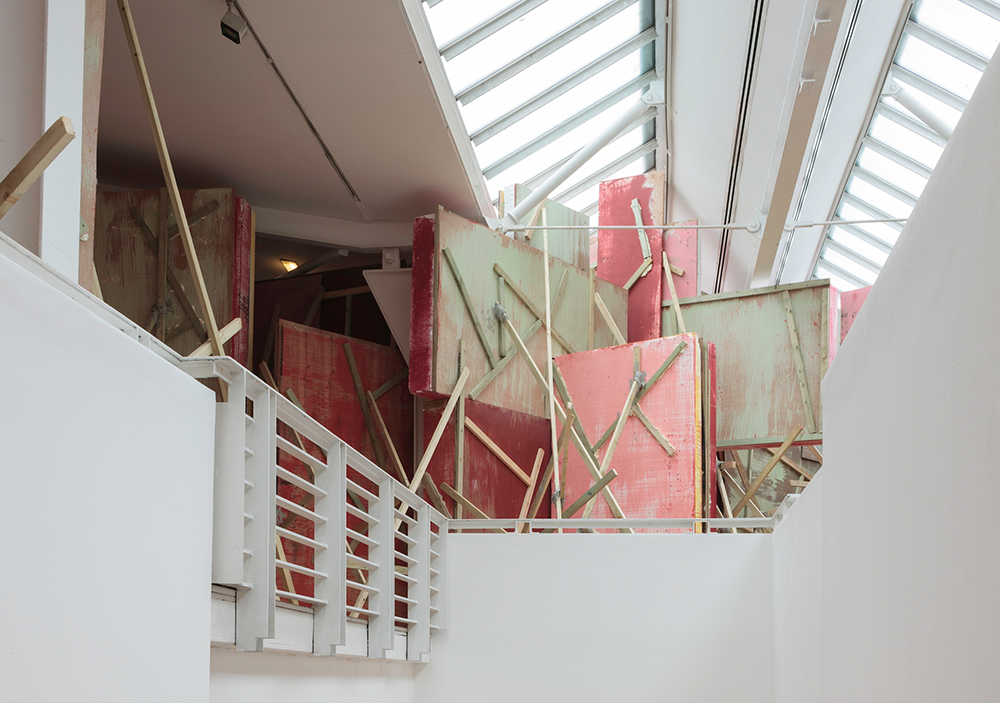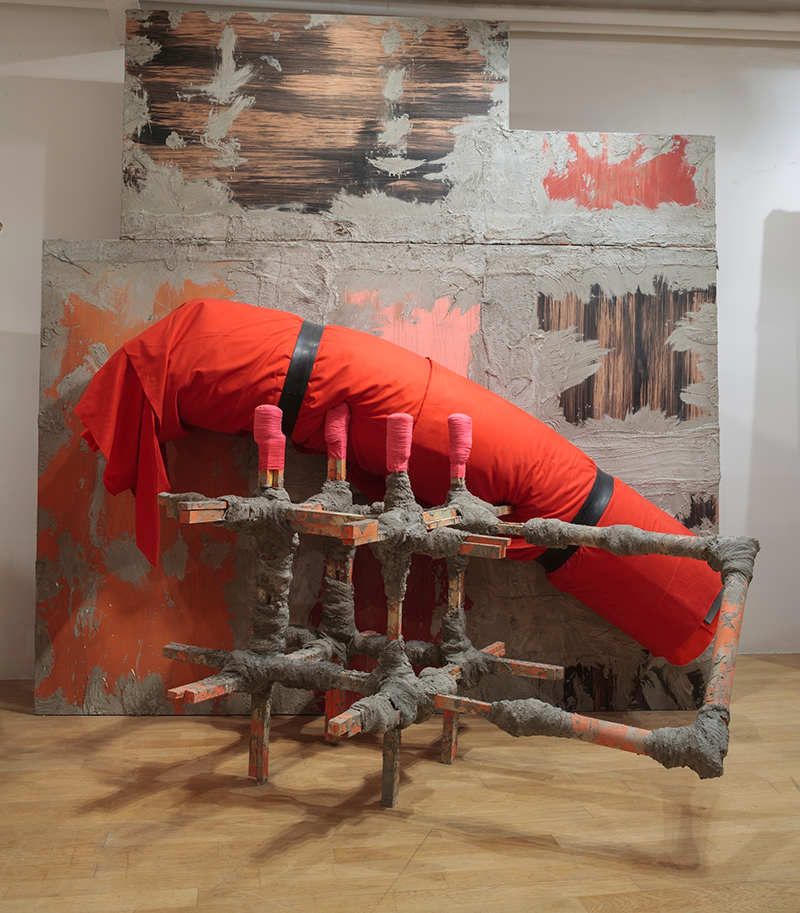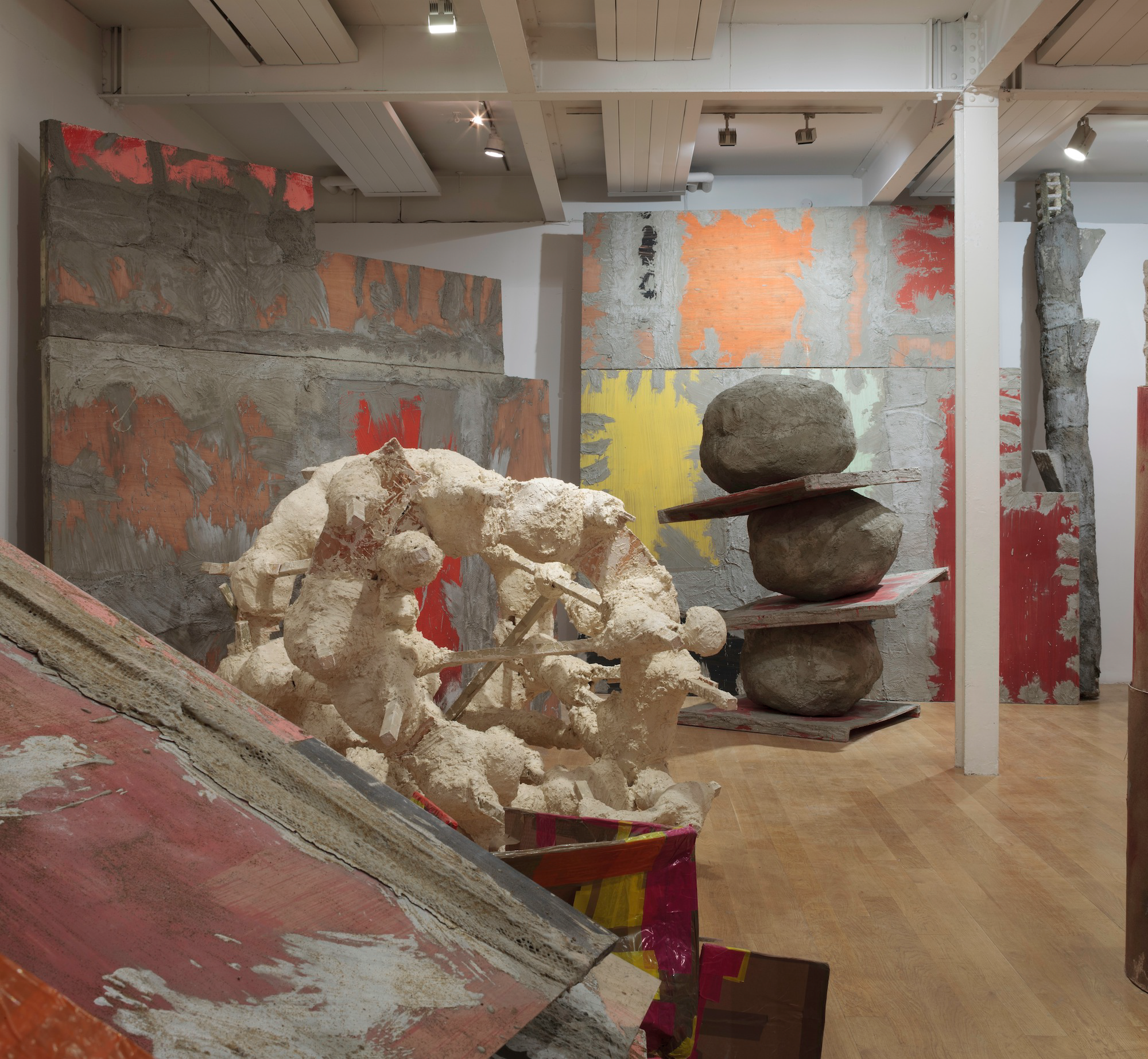Exhibition 27 June – 18 October 2015, The Fruitmarket Gallery, Edinburgh
By Maro Psyrra
In March 2014, Phyllida Barlow (born Newcastle upon Tyne, 1944) presented her largest and
most ambitious work(i) in London for the Tate Britain Commission. It was a monumental
installation constructed with simple materials – such as cloth, electrical wiring, wood,
polyester etc. – which conversed harmoniously with the space, despite the apparent lack of
order in the composition. Her pluralistic sculptural constructions, which in many cases
resembled piles of useless objects, constituted a narrative environment which sought the
spectator’s participation and to the utmost extent “took advantage” of all the architectural
elements of the Duveen Galleries: the high ceiling, the natural light, and its almost
ecclesiastical architecture.
For Barlow(ii) the sculptural object, despite its normally static identity, is restless and
unpredictable in how it can use space. This conviction of hers was expressed superlatively in
the Tate exhibition, but the creative spirit of the British sculptress remained restless. Her
most ambitious work, in my opinion, is presented today at the Fruitmarket Gallery in the
context of the Edinburgh Art Festival 2015(iii). The new installation-exhibition by Phyllida
Barlow, under the general title Set, has literally transformed the gallery’s space, offering a
stirring experience to the attendants.
One does not need to know the architectural characteristics of the Fruitmarket Gallery to
comprehend the “interventional participation” of the artist nor does one need to be familiar
with her work. Once again through ordinary materials she constructs forms of varying
dimensions which forge a new space, within that already extant.
The two floors of the gallery are flooded by the sculptural objects, which have been situated
beyond the traditional locations preferred by curators and artists for the exhibition of works.
Yet Barlow is not interested in a sculpture of vision but in a sculpture which constitutes an
experiential process. Colours, objects, walls and natural materials are interlaced and create
an active environment, within which movement constitutes a ritual or a choreography(iv), as
the artist has said herself in the past. The spectator-participant of the work constantly
discovers ways to move within the installation and explore the various references and
possible interpretations.
Barlow’s “disobedient” art is not a hodgepodge of unfamiliar objects, but a deep, conscious,
artistic expression which draws its inspirations from Picasso’s cubism, up to El Lissitzky’s
Proun Rooms (1923), and Robert Rauschenberg’s or Joseph Beuys’ works(v). Those artists
adopted the practices of modern sculpture with new approaches and altered the
relationship between space, artwork and spectator. Based on this understanding, Barlow in
turn abolishes the limits of space, she readjusts them and transforms them using an
amalgamation of artistic forms. Besides, for Barlow modern sculpture is “walls that come
away from walls”(vi).

Phyllida Barlow, Untitled: Blockade, 2015
Timber, polystyrene, paint, scrim, cement, plaster, bonding plaster, plywood, foam board, cardboard, pinboard, approx. 430 x 1240 x
1800 cm.
Courtesy the artist and Hauser & Wirth (Photo: Ruth Clark)

Phyllida Barlow, Untitled: Contraption, 2015
Timber, plywood, scrim, cement, sand, paint, cardboard tube, upholstery foam, felt, fabric, rubber, 360 x 350 x 280 cm.
Courtesy the artist and Hauser & Wirth (Photo: Ruth Clark)

Phyllida Barlow: Untitled: Boxes, 2015
Timber, plywood, paint, cardboard, paper, plastic, bonding plaster, sand, PVA, 380 x 410 x 260 cm.
Courtesy the artist and Hauser & Wirth (Photo: Ruth Clark)

Phyllida Barlow, Installation view: set, The Fruitmarket Gallery, Edinburgh, 2015
Courtesy the artist and Hauser & Wirth (Photo: Ruth Clark)
i Tate’s Press release about the exhibition: http://www.tate.org.uk/whats-on/tatebritain/
exhibition/tate-britain-commission-2014-phyllida-barlow (17.08.2015). For more:
ii Phyllida Barlow, Artist Proposal in http://www.tate.org.uk/whats-on/tate-britain/exhibition/tatebritain-
commission-2014-phyllida-barlow/exhibition-catalogue/proposal (17.08.2015)
iii Bradley, Fiona (ed.), Phyllida Barlow: Sculpture 1963 – 2015, Ostfildern: Hatje Cantz, 2015 (exh. cat.)
iv Phyllida Barlow, speaking at Chelsea College of Art and Design, 30 June 2010.
v Catherine Elwes, Installation and the Moving Image, Columbia University Press: 2015, p. 39.
vi Phyllida Barlow, speaking at Chelsea College of Art and Design, 30 June 2010.


